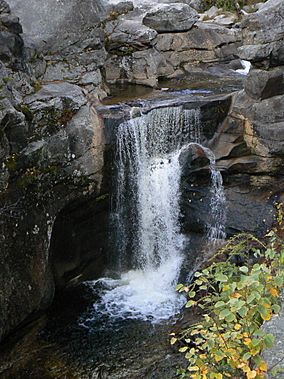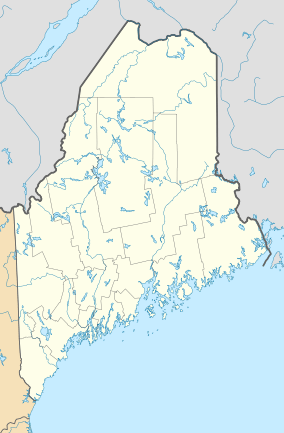Grafton Notch State Park facts for kids
Quick facts for kids Grafton Notch State Park |
|
|---|---|

Screw Augur Falls
|
|
| Location | Grafton, Oxford, Maine, United States |
| Area | 3,129 acres (12.66 km2) |
| Elevation | 1,601 ft (488 m) |
| Established | 1963 |
| Operator | Maine Department of Agriculture, Conservation and Forestry |
| Website | Grafton Notch State Park |
Grafton Notch State Park is a cool outdoor place in Maine, USA. It's a big park, covering about 3,129 acres. This park is found in Oxford County, near a mountain pass called Grafton Notch. This pass is located between two mountains: Old Speck Mountain and Baldpate Mountain.
The park is next to even more protected land called the Mahoosuc Public Reserved Land. This extra land adds up to about 31,807 acres! The Maine Department of Agriculture, Conservation and Forestry takes care of Grafton Notch State Park. It's a great spot to explore nature and see amazing sights.
Contents
Park History: How Grafton Notch Began
Grafton Notch State Park was created in 1963. The state of Maine started buying land for the park that year. They bought about 2,875 acres from a company called Brown Company.
Over the next few years, especially in 1964, more small pieces of land were added. These were often less than 5 acres each. By 1977, the park's borders were set when two more one-acre pieces of land were added.
Wildlife: Animals You Might See
Grafton Notch State Park is home to many different animals. If you enjoy watching birds, you might spot various songbirds and birds that migrate through the area. Sometimes, even large birds of prey like eagles, falcons, and hawks are seen flying overhead.
On the hiking trails, you might see bigger animals. These include black bears, moose, and white-tailed deer. Other animals like foxes, bobcats, coyotes, and fishers also live in the park. Remember to always keep a safe distance from wildlife.
Geology: How the Land Was Shaped
The amazing landscape of Grafton Notch was formed a long, long time ago. Giant sheets of ice, called glaciers, carved out the land during the Ice Age. This process is called glaciation.
Ice Age Features: Valleys, Gorges, and Eskers
As the glaciers moved, they created U-shaped valleys. You can also see deep gorges and long, winding ridges called eskers. The rocks in the park are unique. They are made of Devonian granite with special rock formations called pegmatite intrusions.
You can also find different types of rocks and gravel scattered around. These show how the glaciers deposited materials as they melted. Large boulders, called erratics, were left behind by the ice on the valley floor.
Famous Gorges: Waterfalls and Caves
Grafton Notch has some really cool gorges. These include Screw Auger Falls, Mother Walker Falls, and Moose Cave.
Screw Auger Falls
Screw Auger Falls is in a steep gorge along the Bear River. When the water level is low, you can see the erratics (boulders left by glaciers) in the stream.
Mother Walker Falls
Mother Walker Falls shows off steep cliffs and a flat valley floor. These are classic signs of glacial erosion. Scientists still discuss exactly how these gorges formed. They might have been shaped by a lot of meltwater from the ice sheet. Or, they could have formed under the ice sheet when water was under high pressure.
Moose Cave
Many pegmatite veins, which are special rock formations, are visible around the water-eroded bedrock in these gorges.
Activities and Fun Things to Do
Grafton Notch State Park offers many exciting things to do. The park's beautiful mountain scenery includes the stunning Screw Auger and Mother Walker waterfalls. You can also explore the cool Moose Cave.
Outdoor Adventures
- Fishing: Cast a line and try to catch some fish.
- Hunting: Hunting is allowed in certain areas during specific seasons.
- Picnicking: Enjoy a meal outdoors with family and friends.
Hiking and Climbing
The park has a tough, 12-mile section of the famous Appalachian Trail. This trail is popular with hikers from all over. For those who love a challenge, the park is also known for its extensive ice climbing. There are routes for both beginners and advanced climbers.


